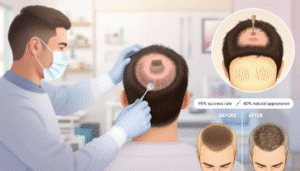For a hairline transplant, you may need between 600 to 3,500 grafts, depending on your hair loss stage and desired density. Factors like hair type and individual goals also influence how many grafts for hairline transplant. This article will help you understand how to determine your graft needs for a natural-looking result.
Key Takeaways
- A hairline transplant involves relocating hair grafts from dense areas to balding regions, with the goal of achieving a natural appearance, particularly through the Follicular Unit Extraction (FUE) method.
- The number of grafts needed for a hairline transplant is determined by factors such as the extent of hair loss, desired hair density, and individual hair characteristics, utilizing the Norwood Scale for assessment.
- Costs for hairline transplants can range from $4,000 to $15,000, depending on the graft count and procedure extent, with financing options available but typically not covered by insurance.
Hairline Transplant Basics

A hair transplant is a surgical procedure that relocates hair from dense areas to bald or thinning regions on the scalp. Hair transplant grafts are a popular hair restoration method that involves transferring small sections of skin with healthy hair follicles and hair follicle to the target area. This precise technique achieves a natural appearance, especially with the Follicular Unit Extraction (FUE) method.
An FUE hair transplant procedure aims to create a natural-looking hairline that blends seamlessly with the patient’s existing hair. This method allows for meticulous placement of each hair graft, ensuring aesthetically pleasing and virtually undetectable results. Patients should maintain realistic expectations, understanding that while the procedure can significantly improve hair density, it may not fully restore hair to its original state. Fue hair transplants can be an effective solution for those seeking to enhance their appearance.
Candidates for hair transplantation usually have healthy hair growth at the donor site, often the back of the head, providing the necessary donor hair. Each hair graft, sourced from the patient’s own transplanted hair, is crucial for the transplant’s success.
Advancements in techniques and skilled surgeons have made it possible to achieve natural hairline more attainable than ever before.
Determining Graft Numbers for Hairline Transplants
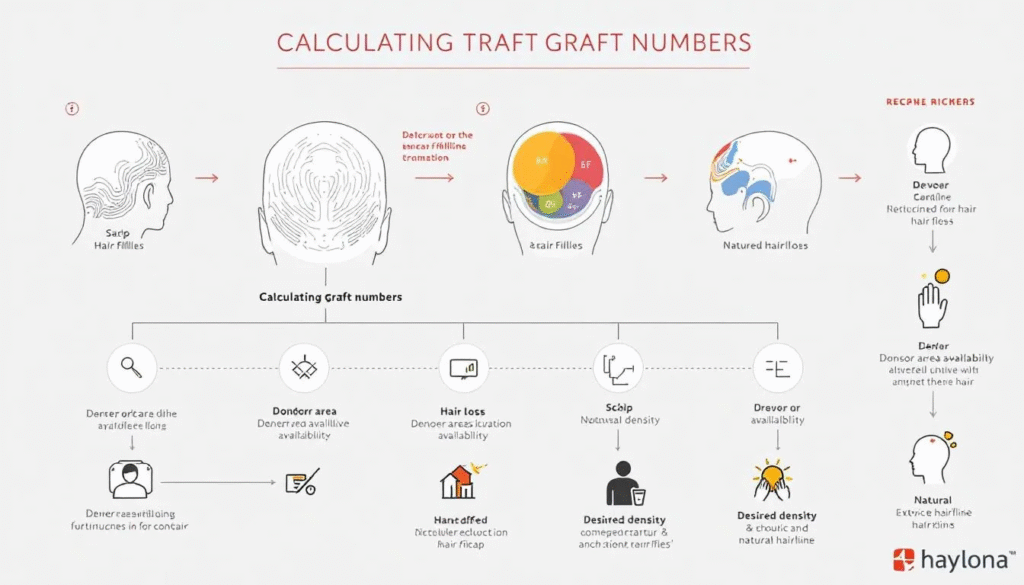
Determining the number of grafts needed for a hairline transplant involves considering several factors: the extent of hair loss, desired hair density, and individual hair characteristics. Understanding these elements is crucial for achieving a successful hair transplant that meets patient expectations.
The first step in the graft hair transplant process is assessing the extent of hair loss, which significantly affects the total number of grafts required. Desired hair density is then considered to determine how many grafts are needed for a natural look.
Finally, hair characteristics such as thickness, texture, and color determine the number of grafts necessary for effective coverage.
Assessing Hair Loss Extent
Assessing hair loss extent is crucial for determining how many hair grafts are needed as hair loss progresses. The Norwood Scale categorizes hair loss stages into seven stages, helping to estimate graft numbers for treatment. This analysis allows hair transplant surgeons to provide a more accurate graft estimate tailored to each patient’s needs.
For example, patients at Norwood Stage 5 may require between 2,500 to 3,500 grafts to achieve satisfactory coverage. Factors such as larger areas of hair loss can increase graft requirements, making it essential to have a thorough assessment to determine the exact number of hair grafts needed and what grafts do I need.
Desired Hair Density
Desired hair density significantly influences the number of grafts needed for a hair transplant. Patients preferring thicker hair will typically need more grafts than those opting for a more natural look. This preference guides both the surgeon and the patient in achieving optimal graft placement.
Understanding patient preferences helps set realistic expectations and ensures a satisfying, natural-looking outcome. Opting for higher density may require more grafts but can lead to a more youthful and fuller appearance.
Hair Characteristics
Hair characteristics critical in determining the number of grafts needed for effective coverage include:
- Thickness: Finer hair may require more grafts compared to coarser hair for similar coverage.
- Texture
- Color: Certain hair colors may require fewer grafts for adequate coverage.
Understanding these hair characteristics allows surgeons to ensure the number of grafts transplanted achieves a natural and full appearance. This personalized approach maximizes the effectiveness of the hair restoration surgery and achieves the desired results.
Typical Graft Estimates for Hairline Transplants
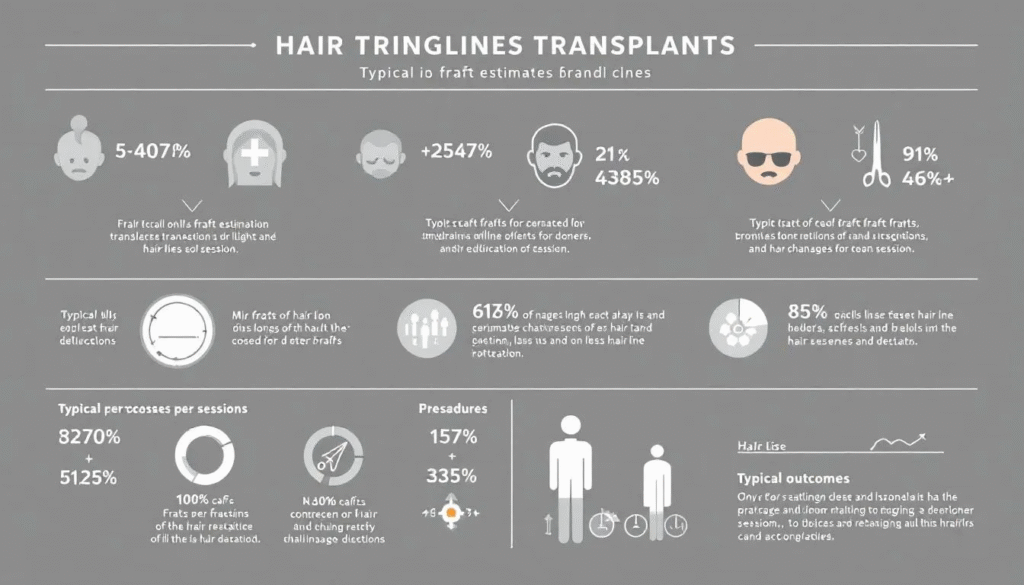
The number of grafts needed for hairline transplants varies significantly based on the extent of hair loss. For minimal hair loss, around 600 grafts may be sufficient. Mild hair loss typically requires 800 to 1,500 grafts, addressing minor recession and providing noticeable improvement in hair density.
Patients with moderate hair loss typically need 1,000 to 2,000 grafts. For instance, those at Norwood Stage 3 may require 1,500 to 2,000 grafts for satisfactory results. An example of a patient needing around 1,380 grafts highlights the variability in graft numbers.
For severe hair loss, particularly extensive balding, around 3,000 grafts or more may be necessary. Patients at advanced stages, such as Norwood Stage 7, might require 4,500 or more grafts for effective coverage. Understanding these typical hair graft calculation estimates helps set realistic expectations and plan for the hair transplant procedure.
Maximizing Donor Area Efficiency
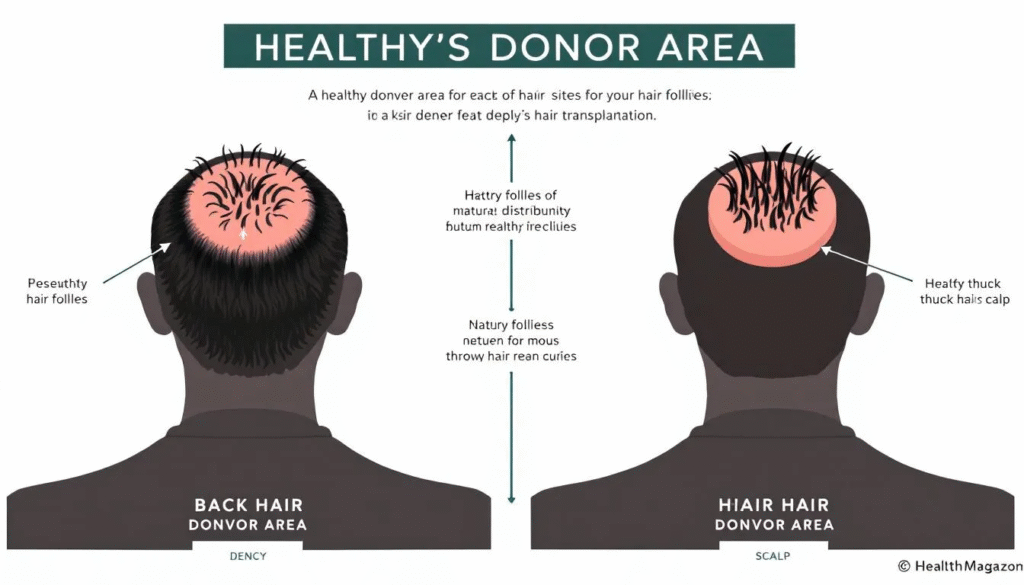
Maximizing donor area efficiency is crucial for a successful hair transplant. Surgeons evaluate the health of the donor area to estimate the number of grafts that can be safely extracted. This evaluation helps prevent overharvesting, protecting the donor area’s viability for future procedures.
Combining techniques, such as Follicular Unit Transplantation (FUT) and Follicular Unit Extraction (FUE), can yield additional grafts and enhance the overall outcome. Using both methods can provide an additional 2,000 to 3,000 grafts, offering greater flexibility in achieving the desired hair density.
Maintaining the health and viability of the healthy donor area is essential for long-term hair restoration success.
The Role of Professional Consultation
Consulting a hair transplant surgeon is a critical step in the hair restoration journey. Experts provide accurate information about the number of grafts needed based on individual balding patterns and characteristics. This tailored approach ensures patients receive the most appropriate treatment plan.
Professional consultations help set realistic expectations for hair transplant outcomes. By understanding the patient’s goals and assessing hair loss extent, specialists provide a detailed graft estimate and guide patients through the entire process.
Case Studies: Before and After
Real-life case studies offer valuable insights into the transformative power of hairline transplants. These examples show how different graft numbers achieve varying levels of hair restoration. Whether dealing with minimal, moderate, or severe hairline recession, these case studies highlight the noticeable improvements achievable through hair transplants.
The following subsections explore three case studies involving different graft ranges: 800-1000 grafts, 1500-2000 grafts, and 2500+ grafts. Each case study showcases the patient’s journey, the number of grafts used, and the resulting transformation.
800-1000 Grafts
Patients with minor hairline recession often require fewer grafts for satisfactory results. For instance:
- A case study involving 800 to 1000 grafts demonstrated significant improvement.
- This range is ideal for minimal hair loss.
- It provides effective coverage without extensive procedures.
- The result is a natural and youthful look.
Applying 800 to 1000 grafts can noticeably enhance the hairline, blending seamlessly with existing hair and offering a more youthful appearance. This case study underscores the potential for excellent results with a relatively small number of grafts.
1500-2000 Grafts
Patients with moderate diffuse thinning may need 1500 to 2000 grafts for considerable improvement. Moderate hair thinning affects many individuals’ aesthetic appeal and self-confidence. Addressing this level of hair loss with the appropriate number of grafts can visibly thicken the hairline and improve overall satisfaction with appearance, even in cases of mild thinning.
One case study highlighted a patient who received 1500 to 2000 grafts, resulting in significant fullness and improved hair density. This approach enhanced the patient’s hairline and reinforced personal confidence and satisfaction with the results.
2500+ Grafts
Severe hairline recession often requires significant intervention for desired restoration. In a case study involving over 2500 grafts:
- The patient experienced comprehensive restoration.
- Temple recession and extensive balding were addressed.
- The large number of grafts provided a fuller appearance.
- Bald patches were effectively covered.
Using 2500+ grafts can tackle extensive hair loss, ensuring a natural-looking hairline and overall coverage. This case study demonstrates the transformative potential of more hair grafts for severe hair loss and graft survival.
Post-Transplant Care for Optimal Results
Post-transplant care is essential for achieving optimal results. Recovery from hair transplant surgery usually takes place on an outpatient basis, allowing patients to leave the same day. The scalp may initially show mild swelling, redness, and scabbing, which is normal.
Adequate rest in the first few days post-surgery is crucial for smoother recovery. Essential care includes:
- Keeping the scalp clean and moisturized
- Avoiding direct sunlight and excessive sweating
- Regularly applying saline spray to accelerate healing and prevent infection
- Gently washing the scalp, which can usually begin around five days after the transplant, aiding in scalp restoration.
Patients should consider the following after a hair transplant:
- Refrain from using hair products or heat tools for a period following the transplant.
- Understand that full results may not be visible for up to a year as the hair goes through a healing and growth cycle.
- Be aware that the process may require multiple sessions to achieve the desired density.
- Allow healing periods between procedures lasting several months.
Avoiding heavy lifting and strenuous exercise is crucial for at least a month after surgery.
Cost Considerations for Hairline Transplants
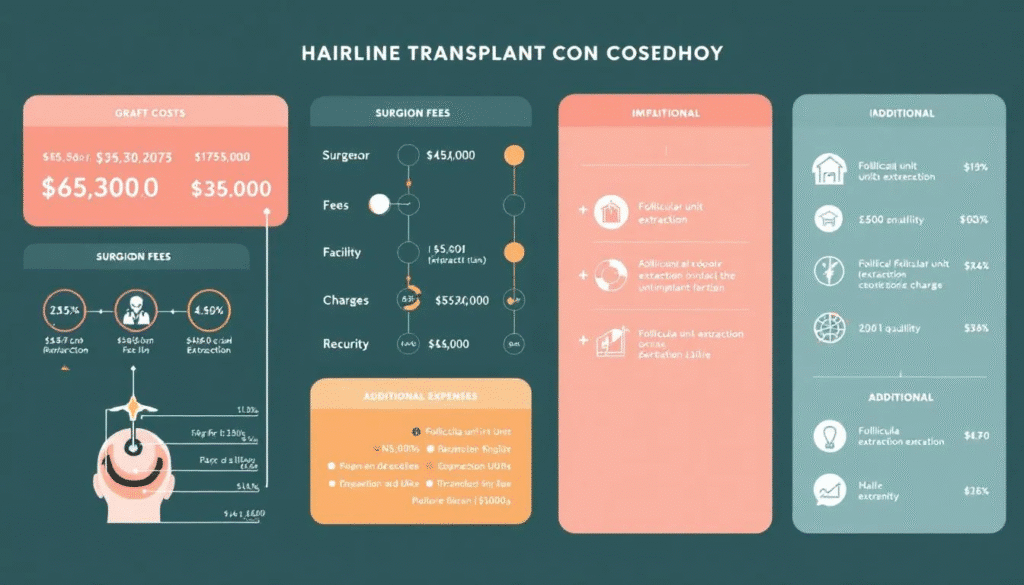
The cost of hairline transplants varies significantly, depending on the number of grafts needed and the extent of the procedure. Key cost details include:
- The total expense can range from $4,000 to $15,000.
- The average cost per hair for an FUE hair transplant is around £2.50 per hair.
- The average cost range for a hair transplant is between £7,500 and £10,000, making it a significant investment.
Financing options are often available through hair transplant clinics, allowing patients to manage costs over time. However, insurance typically does not cover hair transplant procedures due to their cosmetic nature. Understanding these cost considerations helps patients plan their hair restoration journey effectively.
Summary
In summary, hairline transplants offer a transformative solution for individuals struggling with hair loss. Understanding the factors that determine the number of grafts needed, such as the extent of hair loss, desired density, and hair characteristics, is crucial for achieving optimal results. Real-life case studies highlight the potential for significant improvements through varying graft numbers, while professional consultations ensure tailored treatment plans.
Embarking on a hair restoration journey requires careful planning, professional guidance, and a commitment to post-transplant care. With the right approach, achieving a natural and fuller hairline is within reach, offering renewed confidence and a more youthful appearance.
Frequently Asked Questions
How many grafts are needed for a hairline transplant?**?
The number of grafts required for a hairline transplant generally ranges from 600 for minimal hair loss to over 4,500 for severe cases, depending on individual factors such as hair density and characteristics. It is essential to consult a specialist to determine the precise needs based on your specific situation.
What factors influence the number of grafts required for a hair transplant?**?
The number of grafts required for a hair transplant is influenced by the extent of hair loss, as determined by the Norwood Scale, the desired hair density, and individual hair characteristics such as thickness, texture, and color. These factors collectively determine the optimal approach for achieving satisfactory results.
How is the donor area evaluated for a hair transplant?**?
The donor area is evaluated based on the health and density of the hair follicles to determine the number of grafts that can be safely harvested, preventing overharvesting and maintaining its viability for future procedures. This careful assessment is crucial for the success of the hair transplant.
What is the recovery process like after a hair transplant?**?
The recovery process after a hair transplant involves managing mild swelling, redness, and scabbing, while ensuring the scalp remains clean and moisturized. It is important to note that full results may take up to a year to become visible.
How much does a hair transplant cost?**?
A hair transplant typically costs between $4,000 and $15,000, influenced by the number of grafts required and the procedure’s complexity. Financing options may be accessible, though insurance generally does not cover this cosmetic procedure.

